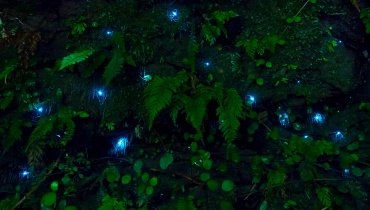
Let’s take a moment to break down the science behind their glow. You might be wondering, “Why do some glow worms shine blue while others glow green?” This variation isn’t just random; it’s tied to their biology, environment, and even their stage of life. In this article, we’ll dive into the mechanisms of bioluminescence in glow worms and explore why their light colors vary.
What Are Glow Worms, Anyway?
Before we get into the nitty-gritty of light color variations, let’s talk about what glow worms actually are. Contrary to what the name might suggest, glow worms aren’t worms at all. Most glow worms are the larvae of various species of beetles and flies, notably from the family Lampyridae. These larvae have a special trick up their sleeves: they can produce light through a process called bioluminescence.
Imagine being able to create your own light source whenever you wanted! That’s essentially what glow worms do. They emit light to attract prey, such as insects, into their sticky silk traps. The soft, mesmerizing glow not only draws in potential meals but also adds an air of magic to the night. The light they produce can be mesmerizing, drawing tourists and scientists alike to their habitats.
The Chemistry of Bioluminescence
Let’s break this down a bit. The light you see from glow worms comes from a chemical reaction that occurs in their bodies. Here’s the basic rundown: glow worms contain a molecule called luciferin and an enzyme called luciferase. When luciferin reacts with oxygen, it produces light in a reaction that’s pretty energy-efficient—meaning they don’t waste a lot of energy while glowing.
You might be thinking, “That sounds like magic!” but it’s pure chemistry. The color of the light produced—whether it’s blue, green, or even orange—depends on several factors, including the type of luciferin and the conditions in which they’re glowing.
Why Do Glow Worms Change Color?
Now here’s where it gets interesting. The *color* of a glow worm’s light can actually vary based on several factors:
- Species: Different species of glow worms produce different colors. For example, the Australian glow worm, known as the *Arachnocampa luminosa*, typically emits a bluish light, while some other species might glow green.
- Environment: The chemical composition of their environment, like the pH level and humidity, can affect light color as well. Some researchers have found that a more acidic environment may enhance the production of blue light.
- Age: Just like us humans, glow worms undergo various life stages. Younger larvae might emit different colors than older ones, which are more mature and can produce a stronger light.
So, the next time you see a glow worm shining, you might want to think about all the factors at play behind that lovely glow!
The Role of Color in Survival
It might seem whimsical, but the color of light can actually play a crucial role in survival. Blue light is often more effective at attracting insects since many flying insects are sensitive to this wavelength. Conversely, a green glow might be used in specific situations, perhaps to attract different types of prey or to adapt to varying environmental conditions.
Think of it like a glow worm’s survival toolkit. By having the ability to change their light color, they can optimize their hunting strategy, making it easier to catch food and thrive. This adaptability is what makes them so successful in their habitats.
Glow Worms Around the World
Glow worms aren’t just found in one location; they have their glowing moments in various parts of the world. For instance, New Zealand is famous for its glow worm caves, where tourists can take boat rides under a ceiling of twinkling lights. These glow worms are actually a specific species, *A. luminosa*, and they put on quite a show.
On the other hand, there are glow worms in the United States, like the *Lampyris noctiluca*, but they exhibit different light properties. The diversity of glow worms around the globe showcases just how unique these creatures are. They have adapted their glowing techniques to fit different climates and ecosystems.
The Future of Glow Worm Research
As scientists continue to study glow worms, we’re gaining better insights into their light-producing capabilities. This research isn’t just for fun; understanding bioluminescence can have real-world applications, such as developing new sustainable light sources or improving pest control methods in agriculture.
Imagine the possibilities! If researchers can unlock more secrets about how glow worms produce their light, we might find ways to replicate this process in technology. It’s a captivating challenge that combines nature and science, showcasing the marvels of evolution.
How Can You See Glow Worms?
If you’re eager to experience the enchanting glow of these creatures yourself, there are a few key places around the world to catch a glimpse. In New Zealand, you can visit places like the Waitomo Caves, which are renowned for their stunning glow worm displays.
In Australia, spots like the Tunnel of Love in the Blue Mountains offer similar experiences. Be sure to check the best viewing times, typically at night when the glow is more vibrant. Remember, while it’s tempting to take photos, flash photography can disturb these creatures, so it’s best to enjoy the moment quietly.
Glow worms are more than just dazzling lights in the dark; they’re a fascinating blend of biology, chemistry, and nature’s magic. Understanding the variations in their light color gives us a glimpse into their survival strategies and adaptability. From the species-specific glow to the environmental influences that shape it, these little creatures are a reminder of the complex relationships between organisms and their environments.
So, the next time you’re lucky enough to spot a glow worm, take a moment to appreciate not just the beauty of its glow but the science behind it. It’s a world filled with wonder, just waiting to be explored.
